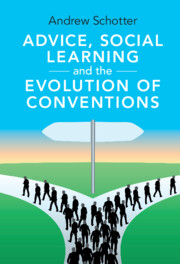Book contents
- Frontmatter
- Dedication
- Brief Contents
- Contents
- Figures
- Tables
- Preface
- 1 Introduction
- Part I Background
- 2 Advice
- 3 Conventions, Social Learning, and Intergenerational Games
- Part II Coordination, Distribution, and Trust Conventions
- Part III The Impact of Public Advice and Common Knowledge
- Part IV The Value of Advice
- Part V Advice and Economic Mechanisms
- Index
3 - Conventions, Social Learning, and Intergenerational Games
from Part I - Background
Published online by Cambridge University Press: 09 March 2023
- Frontmatter
- Dedication
- Brief Contents
- Contents
- Figures
- Tables
- Preface
- 1 Introduction
- Part I Background
- 2 Advice
- 3 Conventions, Social Learning, and Intergenerational Games
- Part II Coordination, Distribution, and Trust Conventions
- Part III The Impact of Public Advice and Common Knowledge
- Part IV The Value of Advice
- Part V Advice and Economic Mechanisms
- Index
Summary
In this chapter we start by defining an intergenerational game and its equilibria. We then discuss conventions of behavior, their relationship to intergenerational-game equilibria, and what it takes to make such conventions stable. This is followed by describing the relationship between our use of the term “social learning” and what standard economic theory interprets it to mean. At the end of the chapter we discuss two other types of games, dynastic games (Anderlini, Gerardi, and Laguno, 2008) and overlapping generations games (Kandori, 1992), which also have generational structures.
Keywords
- Type
- Chapter
- Information
- Advice, Social Learning and the Evolution of Conventions , pp. 45 - 76Publisher: Cambridge University PressPrint publication year: 2023

